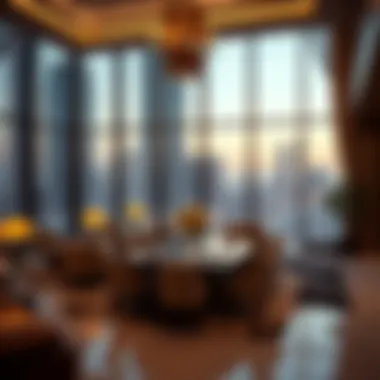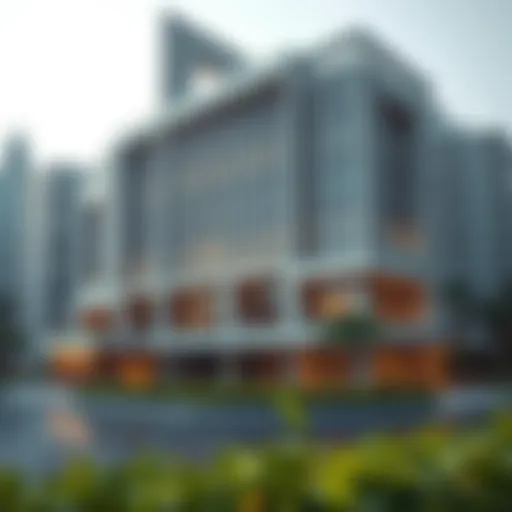Insights into Dubai's Real Estate: JLT and Taj Overview


Intro
Dubai's real estate market is a dynamic and ever-evolving landscape, and it offers exciting opportunities for investors, homebuyers, and property enthusiasts alike. Among the many neighborhoods that contribute to this complex market, Jumeirah Lake Towers (JLT) and the grandeur surrounding the Taj stand out.
Understanding the essence of these two areas provides crucial insights into the overall market trends in Dubai. JLT, with its skyscrapers and man-made lakes, is known for its vibrant lifestyle and business-friendly environment. On the other hand, the Taj represents luxury and elegance, appealing to those looking for a lavish living experience. Both areas attract distinctive demographics, contributing to varied investment dynamics.
In this article, we’ll dissect current market trends, dive into prices, and provide a comprehensive buying and renting guide tailored for first-time buyers. By exploring these aspects, the aim is to offer a detailed perspective that aids readers in making well-informed decisions within Dubai’s real estate framework.
Know What Lies Ahead
Investing in real estate requires a keen understanding of market signals. It’s not just about the present; future predictions can significantly influence your next move. With this in mind, let’s delve into the trends that shape the current landscape, starting with an examination of real estate prices.
Preamble to Dubai's Real Estate Market
Understanding the real estate market in Dubai is no small feat. Within the bustling landscape of this modern metropolis, there exist diverse opportunities and challenges, particularly in sought-after locales like Jumeirah Lake Towers and the Taj. The complexities of the market stretch beyond simple buying and selling; they encompass a variety of influences, regulations, and trends. This article aims to dissect these layers to furnish you with a clearer path through the nuances involved.
Why should one immerse themselves in Dubai's real estate market? The city is not just a hub for tourism; it presents robust economic potential, given the influx of expatriates and emerging businesses each year. Additionally, the architectural marvels and cultural amalgamation found here enhance the appeal for investors and residents alike. Therefore, knowing the ropes is essential for making informed decisions.
Overview of the Real Estate Landscape
Dubai's real estate scene is complex, characterized by its rapid growth and transformation. Skyscrapers fill the skyline, each telling a story of ambition and luxury. In the past decade, property prices have seen fluctuations, driven by both local and international factors. The city houses various real estate segments — from luxury high-rises in Downtown Dubai to affordable developments in emerging areas.
Local regulations have evolved to encourage foreign investments, stimulating the market. Buyers and investors alike are attracted by incentives such as no property taxes, making acquisition more appealing compared to it’s global counterparts. However, potential stakeholders must assess areas critically; some developments may not yield returns as expected, especially if they are misaligned with market demand.
- Considerations are crucial:
- Market fluctuations impact property values.
- Location attributes significantly affect desirability.
- Regulatory framework shapes investment viability.
Key Influencers of Market Dynamics
Numerous elements dictate the ebb and flow of Dubai's property scene. Economic stability naturally plays a pivotal role; a robust Gross Domestic Product fosters confidence among investors. Furthermore, fluctuations in oil prices, which have an indirect effect on real estate, can affect market activity as they influence spending and investment from the emirate's primary industries.
- Key Influencers Include:
- Global Events: The Expo 2020 hosted in Dubai has catalyzed demand for properties, both commercial and residential.
- Demographics: The ever-growing expatriate population sustains a consistent demand for housing.
- Interest Rates: Changes affect mortgage expenses; lower rates typically boost buying power among residents.
In essence, understanding these dynamics is akin to being able to read the stars for navigators at sea. Investors who are well-versed in these elements tend to fare better, as they can anticipate shifts and make strategic moves rather than being caught off-guard.
"A market that once seemed like a mirage in the desert is now a landscape ripe for opportunity."
In the labyrinth of Dubai’s real estate, having an informed perspective can be the difference between a wise investment and a financial pitfall.
Exploring Jumeirah Lake Towers
Jumeirah Lake Towers, often abbreviated as JLT, occupies a distinctive position in Dubai's real estate market. This area not only embodies a master-planned community but also acts as a microcosm of the varying dynamics found within the broader Dubai landscape. JLT's importance lies in its diverse offerings, which include a blend of residential, commercial, and leisure facilities that cater to a wide range of preferences. From the developing expatriate community to the seasoned investor seeking profitable property opportunities, JLT presents enticing factors that demand detailed exploration.
Geographical Characteristics
Nestled in the heart of New Dubai, Jumeirah Lake Towers covers an area stretching over 5 square kilometers. The community's layout, characterized by man-made lakes, parks, and a well-connected transportation network, enhances its appeal. Its proximity to major highways and road networks such as Sheikh Zayed Road provides seamless access to Dubai's primary business districts. The location is not just about connectivity; it's also about the breathtaking views offered by the surrounding architecture. Being adjacent to the Dubai Marina and a stone's throw from the beach, JLT captures the essence of luxury living combined with urban convenience.
Architectural Highlights of JLT


The architectural landscape of Jumeirah Lake Towers is a visual feast. Towering skyscrapers, each with its unique design, create a signature skyline that is instantly recognizable. The structures are a blend of modern aesthetics and functional design, making them as practical as they are striking. For instance, buildings like the Almas Tower stand out not only due to their height but also their engineering marvel, housing the Dubai Multi Commodities Centre at its apex.
When strolling through JLT, one can appreciate artful landscaping intertwined with cutting-edge architecture. The use of glass facades, green spaces, and water features not only enhances the atmosphere but also engages residents and visitors alike.
Residential Options in JLT
JLT offers a wide spectrum of residential options that cater to various lifestyles. Whether one is looking for a lavish apartment with panoramic lake views or a more modest studio, options abound. The cluster buildings host more than just homes; they boast amenities that make living here highly desired.
- Luxury Apartments: High-end towers like the Lake Shore Tower tempt homebuyers with spacious layouts and top-tier facilities, including swimming pools, gyms, and dedicated parking.
- Mid-range Units: Many buildings feature apartments that are priced reasonably, attracting young professionals and families looking for a vibrant yet affordable community.
- Amenities Galore: Residents can enjoy parks, jogging tracks, and children's play areas, making it an ideal space for families.
Commercial Opportunities in JLT
As a growing business district, JLT's commercial landscape is robust. A mix of offices, retail outlets, and F&B establishments ensures that the everyday needs of residents and visitors are met. The area is particularly appealing for those seeking to secure high-yield investment opportunities.
- Office Spaces: JLT's office spaces are modern, often outfitted with the latest technology, providing a conducive environment for startups and established businesses alike.
- Retail Therapy: Shopping areas are emerging alongside strategic global brands, adding flair to the community’s shopping experience.
- F&B Scene: A thriving culinary scene has also taken root with cafes and restaurants attracting foodies from all corners of the city.
> _"In JLT, businesses flourish in a stunning backdrop of vibrant community life and exceptional facilities."_
The Taj: A Landmark in Dubai
The Taj stands as more than just an iconic building in Dubai. It embodies a fusion of culture, luxury, and investment potential. In an area thriving with high-rise developments, the Taj attracts the discerning eye, presenting not only a lavish lifestyle but also opportunities that are ripe for investment. Being part of the fabric of Dubai’s real estate scene, understanding the Taj is pivotal for anyone looking to navigate this market effectively.
Overview of the Taj's Cultural Significance
The Taj serves as a beacon of cultural richness in Dubai. Much like its namesake in India, this landmark resonates with a narrative steeped in history, elegance, and architectural achievement. It reflects the intricate design aesthetics that define Dubai while integrating elements from its rich Indian heritage.
Visitors to the Taj experience a sensory journey filled with art, dining, and hospitality that speaks to its deep-rooted values and traditions. The cultural events hosted here often draw attention not just from locals, but from global travelers eager to immerse themselves in what Dubai has to offer.
It's critical for investors and buyers alike to consider how this cultural identity can impact real estate values. A property in such a significant locale cannot be simply seen as a structure but rather as a part of an ongoing story, adding layers to its investment appeal.
Luxury Living at the Taj
When it comes to luxury, the Taj does not hold back. The residences within this landmark offer unparalleled elegance and comfort, designed to cater to the affluent lifestyle of its residents. Imagine waking up to breathtaking views of Dubai's skyline, surrounded by opulence that includes high-end finishes, expansive layouts, and private amenities.
- Amenities: Residents enjoy access to state-of-the-art gyms, lush swimming pools, and wellness centers that are not just facilities but experiences in themselves.
- Dining: World-class restaurants serve globally inspired cuisines, allowing for not just meals, but culinary adventures right at your doorstep.
- Community: The inclusive community of the Taj brings together a diverse group of residents, fostering connections and creating a dynamic living experience.
Securing a property in the Taj goes beyond the walls of the home; it’s about embracing a lifestyle that is meticulously curated for those with a taste for the finer things.
Investment Potential of the Taj
Investing in the Taj holds significant promise, driven by several key factors. First and foremost, luxury real estate in Dubai generally retains its value exceptionally well, even amidst market fluctuations. The Taj, being a name synonymous with premium living, is uniquely positioned to attract high-net-worth individuals, ensuring steady demand.
- Rental Yields: Properties in the Taj often yield higher rental returns, making them attractive for investors looking to maximize cash flow.
- Capital Appreciation: With ongoing developments in the surrounding areas, the potential for capital appreciation remains substantial. As infrastructure continues to enhance connectivity and accessibility in Dubai, properties in prime locations like the Taj are likely to appreciate in value.
- Resale Potential: The luxury sector attracts buyers who are often less price-sensitive, making resale prospects quite favorable, especially for meticulously maintained properties.
"Investing in a property at the Taj is not just a transaction; it’s an invitation into a world of sophistication and growth."
For detailed insights into buying real estate in Dubai, consider visiting resources such as Dubai Land Department or sites offering current market analysis like Property Finder and Bayut.
In exploring the Taj in Dubai, one doesn’t just find a home or an investment; they find a narrative that intertwines luxury and culture, making it a focal point of interest for both residents and investors.
Market Trends and Analysis


Understanding the market trends and analysis is crucial for anybody looking to invest in real estate, especially in Dubai's dynamic landscape. Investors and buyers need to arm themselves with knowledge to make informed decisions. Every shift in the market can lead to relevant changes in pricing, demand, and investment potential. Keeping a finger on the pulse of market dynamics allows stakeholders to anticipate opportunities and avoid pitfalls that can arise in this ever-evolving sector.
Current Pricing Trends in JLT and the Taj
Currently, property prices in Jumeirah Lake Towers (JLT) and the Taj reflect varying trends primarily influenced by supply and demand, community amenities, and economic conditions. For instance, in JLT, prices for apartments have shown resilience due to the area's appealing blend of residential and commercial aspects, alongside its convenience to various lifestyle hubs.
- JLT Pricing Insights:
- Studios range approximately from AED 600,000 to AED 850,000, depending on the view and building amenities.
- Two-bedroom apartments typically sit in the AED 1.3 million to AED 1.8 million range, showcasing steady demand.
Conversely, at the Taj, luxury living commands a premium. The architecture and amenities provided elevate its pricing structure, with offerings often exceeding AED 3 million for high-end apartments. The demand for luxury spaces continues to grow as foreign investments flow into premium markets.
"In Dubai, a property’s worth is often shaped not just by its physical characteristics but also its perceived status among international buyers."
This dual nature of pricing showcases the balance between affordability in JLT and luxury in the Taj. Buyers often need to weigh lifestyle preferences against their budget constraints when considering where to invest.
Predicted Market Shifts
Looking forward, several shifts are anticipated within the JLT and Taj real estate markets. The ongoing urban development initiatives and significant government investments in infrastructure, including the expansion of transport networks, could lead to increased demand.
Factors to consider:
- Economic Recovery: As global economies stabilize post-pandemic, confidence in property investment is poised to rise.
- Expo 2020 and Beyond: The outcomes of events like Expo 2020 have a long-lasting impact, potentially attracting more businesses and residents to Dubai.
- Long-term Rental Increases: Expectations of rental prices rising, especially in desirable locations, could shift more investors toward buying rather than renting.
Moreover, shifts in buyer demographics, potentially moving towards younger, affluent expatriates, could redefine market demand in both JLT and the Taj.
In summary, understanding these trends presents a vital compass for both seasoned investors and first-time buyers, ensuring they make decisions rooted in wisdom rather than impulse.
Guidelines for Buyers and Investors
The Dubai real estate market presents a unique blend of opportunities and challenges for buyers and investors alike. Effectively navigating this landscape requires not just knowledge but also strategic foresight. This section focuses on several crucial guidelines that can significantly influence the outcomes of both purchase and investment decisions.
Key Considerations for First-Time Buyers
Entering the Dubai real estate market for the first time could feel akin to diving into the deep end of a swimming pool. Without a life jacket of knowledge and preparation, the risks can be overwhelming. It's essential for first-time buyers to consider a few vital factors:
- Understanding the Market: Familiarize yourself with the basic dynamics of real estate in Dubai. Knowing the difference between areas like Jumeirah Lake Towers and The Taj, and discerning property types, can provide essential insight into where to invest.
- Set a Budget: Be realistic about your financial capacity. Beyond the property price itself, don’t forget to account for maintenance fees, registration fees, and other costs that could add up faster than a speeding train.
- Work with a Knowledgeable Agent: An experienced real estate agent not only offers properties that fit your needs but also serves as a guide throughout the process. Their local expertise can help avoid pitfalls that new buyers might overlook.
- Inspecting the Property: Any buyer who skips a proper inspection is playing a risky game. It’s critical to assess not just the aesthetics but the integrity of the building and facilities before pulling the trigger on a purchase.
- Legal Framework Understanding: Familiarize yourself with the legal terminology and understand the regulations specific to Dubai's market, including freehold and leasehold distinctions. This knowledge can save you from costly misunderstandings down the road.
Investment Strategies in Dubai Real Estate
When it comes to investing in Dubai real estate, a strategic approach often yields the best results. Here are some essential strategies to keep in mind:
- Market Research is Key: Thorough market research enables investors to identify up-and-coming neighborhoods such as JLT or the luxurious appeal of Taj. Learn about historical price trends, rental yields, and occupancy rates to make informed predictions about future market behavior.
- Consider Off-Plan Purchases: Buying off-plan properties can be a gamble, but with the right due diligence, they often come with financial incentives. These might include lower initial costs and higher returns once the property is finalized.
- Diversification: Spread your investments across different locations and types of properties. This approach can minimize risks—if one asset underperforms, others may compensate for that shortfall.
- Long-Term Focus: The Dubai property market can be volatile; however, a long term holding strategy can offer recovered losses as the market stabilizes. Innovations in infrastructure and tourism can spur again further interest and increase property values over time.
- Expert Consultation: Consult with financial advisors or real estate investment experts to tailor your strategies based on your risk tolerance, financial goals and the current economic climate.
"Understanding the local market, acting strategically, and keeping abreast of regulations can pave the way for successful property investment in Dubai."
By following these guidelines and keeping strategic thinking at the forefront, buyers and investors can approach the Dubai property market with greater confidence and insight. As the landscape continues to evolve, staying informed and adapting strategies will be key to success.
Navigating Legal and Regulatory Framework
Understanding the legal and regulatory framework surrounding real estate in Dubai is crucial for anyone looking to make significant investments in this vibrant market. The laws and regulations not only protect buyers and sellers but also ensure the integrity of the property market. This section sheds light on important legal aspects, highlighting the distinctions between freehold and leasehold properties and the regulatory bodies overseeing these frameworks. Knowledge in this area can significantly boost confidence for both local and international investors.


Understanding Freehold and Leasehold Properties
In Dubai, the terms freehold and leasehold refer to the types of ownership available to purchasers. Freehold properties grant full ownership rights to the buyer, allowing them to possess the property indefinitely. This is often considered the gold standard in property ownership. Buyers of freehold properties enjoy the freedom to sell, rent, or modify their property as they see fit, ultimately enhancing the appeal of investing in certain areas like Jumeirah Lake Towers.
On the other hand, leasehold properties signify a fixed period of ownership, commonly ranging between 30 to 99 years. While leasehold owners can use the property and benefit from it, the land itself remains under the ownership of another entity. This form of ownership can be limiting, particularly when it comes to alterations or transfers. Investors must be mindful not to overlook the differences, especially if they are considering properties in high-demand locations like the Taj.
Things to consider when navigating freehold and leasehold properties:
- Investment Goals: Your intent should influence your choice. If you plan to hold property long-term, freehold may be the better option.
- Market Demand: Leasehold properties may be more affordable and accessible in certain sectors of the market.
- Transfer Methods: Understand how property transfers work with each type of ownership, including possible fees and regulations.
Key Regulatory Bodies and Their Roles
Dubai's real estate market is supported by several key regulatory bodies that help manage and enforce property laws, ensuring a fair and secure environment for all participants. Understanding these entities and their functions can provide insights for buyers and investors alike.
- Dubai Land Department (DLD): This is the primary regulatory authority responsible for property registration, valuation, and monitoring of real estate development. The DLD plays a critical role in ensuring transactions adhere to the law, protecting buyers from fraud and legal pitfalls.
- Real Estate Regulatory Agency (RERA): Operating under the DLD, RERA implements regulations to foster transparency, trust, and stability in the real estate market. It oversees property developers and brokers, ensuring compliance with local laws.
- Dubai Economic Department (DED): Although not exclusively focused on real estate, the DED plays a significant role in business licensing and regulation, which can affect commercial property transactions and investment opportunities.
- Trakheesi: This is an online platform that offers a seamless process for securing permits related to real estate and ensures compliance with legal conditions, such as advertising permits for properties.
"Understanding the regulatory framework in Dubai is no mere formality; it’s the bedrock upon which sound investment decisions are built."
Investors looking to make headway in Dubai’s bustling market should keep abreast of these bodies and their evolving regulations. Ensure adherence to local laws and consult them for necessary permits or approvals. In doing so, one can mitigate risks tied to property ownership and transactions.
Future Outlook for JLT and the Taj
As we peer into the future of Dubai's real estate market, the focus shifts to Jumeirah Lake Towers (JLT) and the Taj, both of which continue to capture the attention of investors and residents alike. Understanding this outlook is crucial, as it not only reflects the growth trajectory of these coveted areas but also hints at the potential challenges that may arise along the way. With myriad factors influencing market dynamics, keeping a keen eye on trends will be vital for making informed investment decisions.
Long-Term Growth Potential
The long-term growth potential of JLT and the Taj is largely anchored in the vision that Dubai has for itself as a global hub. The area's continuous development, marked by government initiatives, infrastructural projects, and economic diversification strategies, positions it favorably for sustained growth.
- Strategic Location: JLT's prime location, nestled between Sheikh Zayed Road and the Dubai Marina, offers easy access to business and leisure destinations, making it attractive for both residents and businesses.
- Infrastructure Developments: Planned expansions and improvements to transit systems, such as the Dubai Metro, can significantly enhance accessibility, driving up demand for real estate.
- Cultural and Recreational Attractions: The Taj, with its rich cultural narrative and proximity to landmarks, is likely to benefit from ongoing tourism growth, ensuring that property values may appreciate over time.
Investors might find particular allure in these attributes, as they suggest not just passive housing but vibrant communities worth investing in—a place where the potential for capital gains feels tangible.
Potential Challenges on the Horizon
However, with opportunity comes the undeniable reality of obstacles. Potential challenges in navigating the JLT and Taj real estate landscapes require careful consideration by investors and homebuyers.
- Market Saturation: With numerous new developments becoming the norm, there’s a risk that the market could become flooded, leading to price stabilization or even declines if demand cannot keep pace.
- Regulatory Changes: As the government evolves its regulations, changes might impact foreign ownership laws or financing options, affecting the investment landscape.
- Economic Factors: Global economic fluctuations can have downstream effects on Dubai’s real estate market. A downturn could potentially dampen demand and rental yields.
The interplay between growth potential and challenges necessitates a nuanced approach. Staying well-informed and adapting to the changing circumstances is key in this ever-evolving market.
In summary, while the outlook for JLT and the Taj appears promising, it remains vital for stakeholders to balance optimism with prudence. A clear understanding of the regional dynamics and global economic environment is essential for anyone looking to navigate the intricacies of the Dubai real estate market.
End
The conclusion of this article is crucial in tying together the various threads of Dubai's real estate market, particularly focusing on Jumeirah Lake Towers (JLT) and the Taj. Throughout the discussion, we’ve highlighted several important aspects, including market dynamics, investment strategies, and legal considerations. This final segment serves to reinforce the insights shared, making it easier for potential investors and buyers to grasp the significance of each element discussed.
Summation of Key Insights
In summary, the Dubai real estate market presents a tapestry of opportunities and challenges. Both JLT and the Taj encompass unique offerings that cater to diverse segments of investors and buyers. Here are the key insights:
- Diverse Market: JLT showcases a blend of residential and commercial properties, while the Taj emphasizes luxury living and cultural significance.
- Market Trends: Awareness of fluctuating prices and emerging trends is essential for making informed investment decisions. For example, JLT has seen a steady increase in popularity due to its strategic location and amenities, while the Taj appeals to high-end buyers seeking opulence.
- Legal Landscape: Understanding freehold versus leasehold properties is vital for navigating the regulatory environment effectively.
This synthesized perspective enhances the reader’s comprehension of how various factors play into the larger context of Dubai's real estate ecosystem.
Final Thoughts on Investing in Dubai
Investing in Dubai's real estate can be both lucrative and complex. As the city continues to evolve, it’s crucial for investors to remain vigilant and adaptable. Here are some final considerations:
- Long-Term Vision: A successful investment often requires a long-term perspective. Property values may fluctuate, but choosing a well-located property in JLT or at the Taj can yield profitable returns over time.
- Research and Networking: Engage with local experts, attend property expos, and utilize resources such as Property Finder to gather insights.
- Regulatory Acumen: Keep abreast of regulatory changes and market stats through platforms like Dubai Land Department or industry reports.















